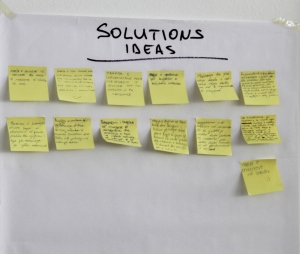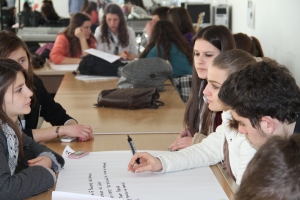We know that this is a big question and there are no strict rules or definitions to identify “what innovation is”. At the Innovations Lab Kosovo we do not try to re-invent the wheel, but encourage using the wheel in different ways. Also, having an innovative idea means being prepared for failure – there are crucial lessons to be learned from failure.
Before you start writing your idea, consider whether someone else has already done the same or something similar – if yes, then try to think about how you can implement the same idea using a different tool or methodology! Think also about how you can use the power of online platforms, new technology and social media.
Need a little nudge? Make sure you are in a preferred place (your room, in the park, sitting in the floor or on your bean bag chair) and make yourself feel comfortable (listen music if that inspires you, go through inspiring pictures on your web browser… just do whatever it is that you think may inspire you!). Start out simple, even funny (“The best ideas come as jokes. Makes your ideas as funniest as possible, “said D. Ogilvy) and brainstorm by yourself by thinking up crazy and absurd ideas. But always write down your ideas on paper. Ask feedback from your colleagues, friends, teachers, mentors and any other relevant person whose feedback may be useful for your idea. You can also invite your friends/colleagues to brainstorm with you.
“Innovation comes from the inside – out, not the outside – in” said Peter Benson (Positive Youth Development pioneer) – and this is what you have to try to do; bring out your innovative thoughts and ideas from within, drawing upon the creative inspiration around you.
Example:
1st Step:
Identify a Social Challenge – How?
Think about a challenge that you and/or your community regularly faces, or make a list of several challenges (e.g. no space for sidewalk, smoking in public spaces, urban traffic jams, no green spaces, bribes in education or business, deforestation etc).
2nd Step:
Select one Challenge – Research?
Always prioritize your challenges, by determining which is the biggest challenge and what benefits you would bring to your community by addressing this challenge. Research whether someone else has already tried to tackle the same issue (within your local municipality, NGO or international organization) and check out how others around the world respond to this challenge (try a simply Google search!). Try to understand how you can best use the power of web- and mobile-based technology and Web 2.0 platforms to address this challenge.
3rd Step:
Design the idea – Benefits vs. Risks?
This is an important step. In this step you have to give shape to your idea. In addition to identifying the benefits that your idea can offer your community, you also must consider the risks of failure. Don`t be afraid to identify the risks, because in doing so you will better shape your idea. Try to identify the tools needed to make your idea real. Nowadays, you can find a huge variety of online tools that can support and increase the visibility of your idea (e.g. maps, fundraising platforms, high-visibility communications channels, surveys etc.). Try to imagine how you can use them for social good/benefit.
4th Step:
Lack of support and expertise – Ask for it!
Your idea may be great. The community you live in would positively benefit from it. You may only need specific expertise at a certain point (e.g. it would benefit from advice from a branding expert or you may need a software developer to adapt a particular platform to your idea. Or, maybe you need a legal expert to ensure that your idea is not breaking out any existing legislation). Good news! At the Kosovo Innovation Camp there will be a pool of mentors and experts dedicated to supporting your idea and working with you to transform it into a concrete product. Here, you can also ask for technical support – a projector, laptops, desktops, GPS devices, smart-phones etc. So, it`s very important to ask for the expertise or support that you need. Whatever it is – just ask for it!
5th Step:
Choose your team, set up strict deadlines and take action!
Team-building!
This is the final step, which involves selecting your team and defining the roles of each team member. Make sure that each team member feels comfortable with their role and don`t ask them to do something that they don`t like. It will only frustrate team members and steer the idea towards technical failure. Everyone must clearly understand their role, and they must thoroughly understand the background of your idea. Try to build team spirit! Frequently speak with each team member and organize informal meetings and events among team members. In the end, don`t forget to celebrate each other`s success.
Setting and respecting deadlines!
If you don`t set up a strict deadlines you will end up wasting a lot of time. Deadlines will help you to achieve your specific goals. Break down your activities into monthly and weekly timelines and set a deadline for each activity. This will help to track your own progress as well as that of your team members. Celebrate each deadline achievement. But don`t forget that another deadline is waiting for you. Always remember that that each deadline you keep brings you one step closer towards the successful transformation of your idea into action.
TAKE ACTION!
You have the idea. You have ensure the necessary support and expertise. You have prepared also your team and established the deadlines. Now it`s time for ACTION. Action is the foundational key to all success. Don`t be afraid to take the first step. You have only to follow your plan and if you face any problems along the way, don`t lose time but deal directly with them as soon as it possible. If you can`t solve it, don`t hesitate to ask for internal or external help/support. Inform each team member at each step of the way. It`s important to be all be on one page, in order to avoid confusion – confusion leads only to delays and misunderstandings.
Taking Action means that you are turning your idea into reality. And turning your idea into reality means that you are trying to bring positive change in your community. You may do it! Or you may fail. It doesn`t matter; the important thing is that you tried to be an agent of positive change within your community. From our perspective, the only failure is the one who is AFRAID to try.
“If you are not prepared for mistake/failure, you will NEVER come up with something original/creative/innovative”. At least you TRIED to be INNOVATIVE!
Ron Salaj, YAP! Social Media Consultant and KIC Coordinator
 AB: After finding out that this would be the most youthful SI Camp, I anticipated issues with the participants’ technical skills and knowledge, however, throughout today I have been consistently impressed and inspired by the enthusiasm and energy shown by all teams, this has more than made up for any lack of experience and – already by the close of the first day of development – the progress that each team has made puts many more experienced teams I’ve worked with to shame.
AB: After finding out that this would be the most youthful SI Camp, I anticipated issues with the participants’ technical skills and knowledge, however, throughout today I have been consistently impressed and inspired by the enthusiasm and energy shown by all teams, this has more than made up for any lack of experience and – already by the close of the first day of development – the progress that each team has made puts many more experienced teams I’ve worked with to shame.









